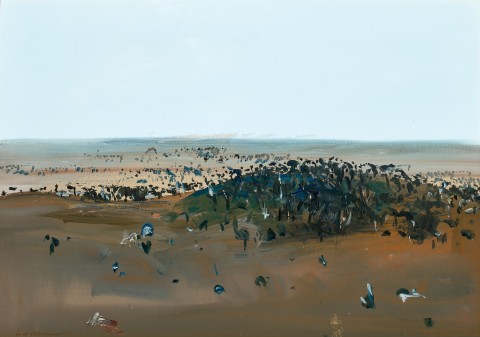LANDSCAPE, 1967
FRED WILLIAMS
gouache on paper on composition board
54.0 x 76.0 cm (sheet)
signed and dated lower left: Fred Williams 67
Private collection
Leonard Joel, Melbourne, 22 November 1994, lot 94
Private collection, Melbourne
We are grateful to Lyn Williams for her assistance with this catalogue entry.
Williams’ distinctive interpretations of the Australian landscape can be read as authoritative exercises in form and gesture, with the barest of markings summarily depicting its unique contours. His rejection of sentimental evocations that were so popular with the Heidelberg school allowed a development of an alternative, semi-abstract vision of the landscape which raises invention and subtlety of vision to a level of singularity that has led us to see the Australian landscape with different eyes. Williams reached his maturity as a painter during the mid-1960s, with his Upwey Series and the preceding You Yangs works attracting unprecedented levels of critical acclaim and positive public reception. Articulating their significance both within Williams’ oeuvre and the broader context of Australian landscape painting, Patrick McCaughey wrote, ‘They were clearly paintings of substance, well made and fully fashioned and yet they still allowed [his] touch to operate. They made of the drab and featureless bush, a landscape of enduring, even monumental proportions and dignity. They revalued Australian landscape painting… and renewed hope in the genre.’1
Thus consolidating and refining his stylistic devices to a rapid shorthand, from 1967 onwards Williams increased the frequency of his outdoor sketching trips, particularly around Lysterfield where he was living at the time, and beyond to Cottles Bridge. The gouache sketches completed en plein air during these expeditions provided important source material, and a passage between a literal impression of the landscape dotted with eucalypts and its further translation into the iconic Williams reductive script, usually in oil paint on canvas.
From this crucible of formal innovation comes Landscape, 1967. Like many other gouaches and paintings from this period, it has a tripartite division, concentrating much of his gestural information in a central band across the paper – the rolling crest of a hill with a crown of trees protruding from the horizon, and pale blue sky beyond. Williams worked in various media throughout his career – the technical possibilities and creative innovations of one invariably influencing his work in another. A quick-drying medium composed of watercolour mixed with white pigment (which renders it opaque), gouache was his preferred medium for painting outdoors during this time. Yet as this example demonstrates brilliantly, in addition to its convenience and ease of use, in Williams’ hands, gouache also offered something of the richness of oil paint in terms of the pictorial possibilities and textural manipulation it allowed.
Significantly, in 1971, Williams devoted an entire exhibition to ‘watercolours’ which, held at the Newcastle Art Gallery before touring, featured fifty works selected by the artist from his own collection from the years 1957 to 1971. Indeed, Williams often exhibited gouaches alongside his oil paintings, and their importance in his oeuvre has continued to be recognised in later major shows including the retrospective Fred Williams: Infinite Horizons, organised by the National Gallery of Australia in 2011.
1. McCaughey, P., Fred Williams 1927 – 1982, Murdoch Books, Sydney, 1996, p. 170
VERONICA ANGELATOS


